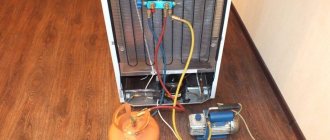A refrigerator is not a capricious household appliance. With proper care and use, it will last 20 years or more. Correct handling begins with the transport stage of the unit. You cannot turn on a new refrigerator for the first time immediately after installation.
The new refrigerator is not turned on immediately
The dimensions of the device often imply transportation in the wrong position. This leads to disruption of the circulation of freon and engine oil in the compressor. When temperatures are low in winter, condensation accumulates inside the refrigerator. The unit must stand vertically in a warm place so that the moisture evaporates and the oil flows out of the refrigerant system.
Briefly about the principle of operation of the refrigerator
Refrigeration equipment operates according to the following principle:
- Inside the body of the unit there are not only chambers for loading products, but also a hardware component. Its main elements are a compressor and a refrigerant (coolant).
- Freon is used as a refrigerant in modern refrigerator models. When transitioning from a liquid to a gaseous state, it absorbs heat, actively cooling the air masses.
- The compressor compresses the refrigerant, causing the substance to become a liquid again and release it into the environment.
- A compressor running on machine oil is started by its motor.
Launch after transportation
Experts recommend turning on the refrigeration unit for the first time, observing the following rules:
- In the spring-summer period, the first launch can be carried out 3-4 hours after transportation.
- In winter, even if the transportation was carried out at a close distance, the refrigerator should stand for 4 to 6 hours.
- When transporting over long distances, the refrigerator is placed in a warm room and is not started for 10-12 hours.
New refrigerator
Why is it important to transport household appliances correctly?
A refrigerator, regardless of the model range, is a complex device consisting of several components. All of them are at risk and may suffer from careless transportation. As a result, the equipment fails. The design of the cooling device, regardless of the model range, includes 2 main components:
- Evaporator (located inside the housing).
- Capacitor (located on the surface of the case at the back).
The two main structural units are made in the form of a coil. Due to the consumption and release of heat, they guarantee the operation of the device. Damage during transport by truck inevitably leads to problems. This can be easily avoided if the rules are followed. You need to find out in advance how the unit works, which performs an important task - maintaining the temperature of food.
Reference! The system contains a refrigerant (more often freon plays its role). It moves along it, the state of aggregation gradually changes (from gaseous to vaporous and transition to liquid).
The cooling system functions as follows:
- The refrigerant enters the system as a gas. After pumping out of the evaporator, heat begins to be absorbed, the freon is now in a vapor state and goes further into the compressor.
- The refrigerant is compressed by the motor piston, thereby creating sufficient pressure for it to enter the condenser.
- Here the freon becomes liquid and cools down. In this form, it overcomes the filter drier and moves towards the evaporator.
- The refrigerant pressure decreases and it boils.
- The refrigerant again becomes a gas, as it was originally, by absorbing the heat of the internal chambers, it cools the space.
- Freon is pumped out.
This cycle repeats endlessly.
Reference! An important part of the cooling process is the compressor. Improper transportation of the refrigerator leads to force majeure with the engine, and the device stops working.
Nowadays, household appliance manufacturers hide the compressor behind a wall. It is practically invisible to the naked eye. But transportation without compliance with the rules leads to serious problems. To prevent this from happening, it is important to know how to transport a refrigerator.
Purchase and transportation
When purchasing a household appliance, they specify how it will be transported. Immediately inspect the integrity of the package. Make sure there is no damage to the glass shelves and check the compartment closing mechanisms.
The device is delivered by special services from household appliance stores. Most often, the service is paid, so you can refuse it. To move on your own, you will need a spacious vehicle, a couple of strong men and knowledge of the rules for transporting refrigerators:
Delivery of equipment by loaders
- The desired position of the device is vertical.
- Allowable roll is 40 degrees.
- In the cold season, they try to get to a room with above-zero temperatures faster.
- If the unit had to be placed in a horizontal plane, it is important to strictly observe the time before plugging the plug into the socket.
Transporting the refrigerator horizontally and on its side
How to reduce risks and which side to transport the refrigerator on are important questions, otherwise you will not be able to do without expensive repairs. It is not advisable to move equipment while lying down. But if the car has low sides, you have to take risks.
What to do before transportation:
- To find out through which tube the freon comes out of the motor, carefully examine the tubes that come out of the motor when the refrigerator is on. If it is warm, hot is the main element that needs to be placed correctly.
- Place the equipment on its side so that the discharge tube that was found is located at the top - a guarantee that when turned on after moving, the oil from the compressor will flow into the return part of the circuit, the cooling system will operate without failures.
If the model has several tubes on one side of the compressor, there is no need to look for a discharge tube. Place the equipment on its side so that all the tubes point upward.
The owner or logistician decides which position for transporting the refrigerator to choose. Lying on one of the sides, delivery of units is acceptable. Moving on the back wall of all models is strictly prohibited. The likelihood of the unit’s thermal insulation being pushed through by its own weight is almost guaranteed. Tubes may break and oil and freon will be incorrectly distributed in the system. Moving parts and the compressor will be defenseless against vibrations and sudden shocks.
You cannot place equipment in the body on the door. It will break and the seal of the locking system will be broken. Oil and freon can mix and the refrigerator will stop working.
How to transport a refrigerator: manufacturers' recommendations
The refrigerator, despite its apparent reliability and solidity, is quite fragile, and improper transportation can lead to damage to the unit. Therefore, most manufacturers recommend transporting the refrigerator in a vertical position - this minimizes the risk of damage to its parts and oil getting into the refrigerant circuit, which can clog the capillary tube and cause the unit to fail.
However, this option is not always convenient: the height of some models exceeds two meters and transporting them in a standing position will require more serious transport than, for example, your personal car with a trailer. A reasonable question arises: is it possible to transport a refrigerator lying down?
How to prepare a refrigerator for transportation
When purchasing a new refrigerator, special services from household appliance stores handle preparations for transportation and delivery.
Reference. When releasing equipment, the manufacturer immediately provides for the availability of reliable packaging for transportation of equipment.
If you plan to move, prepare the household appliance yourself. To do this, per day you need:
- Remove all food supplies from the cells.
- Turn off the device.
- Wait until the unit defrosts.
- Wipe interior and exterior surfaces with dishwashing detergent.
- Remove shelves and drawers and pack them in paper or fabric.
- Secure the compressor with shipping bolts and rope.
- Attach the power cord to the body with tape.
- Secure the door with tape.
- Wrap the refrigerator in a soft cloth, oilcloth, or film. This will protect the unit from scratches.
Ignoring the rules may result in the refrigerator not working properly in the future.
How to mount in a car
Fastening in a car or on a trailer, as well as all loading and unloading operations, is carried out in accordance with the handling signs on the box. The primary task is to securely fix the refrigerator in order to completely eliminate its movement during transportation. Typically, specialized devices for securing large equipment are used for this: belts, stops and rubber gaskets. Wooden boards, polystyrene foam and other available materials without sharp corners can be used as stops. Contact points need additional protection.
When to launch
When to turn on the refrigerator depends on the temperature outside and the method of transportation. The point is the liquids with which the internal system is filled. During loading and transportation, liquids change their location. If you do not allow the refrigerator to sit for several hours, an accumulation of liquids in one place and a deficiency in another will lead to failure of the entire system. If the rules are not followed, the user may not understand that the purchased refrigerator was faulty from the beginning.
Transporting the refrigerator
To make sure that the device purchased in the store is operational, you need to wait 3-4 hours after delivery and then turn on the equipment. In winter, waiting can be extended to 5-6 hours. This is necessary for the refrigerator to warm up to room temperature.
This is interesting: How to make a refrigerator bag with your own hands: step-by-step instructions
If it doesn't freeze after
If the equipment stops freezing after transportation, you should try turning it off and leaving it for a few more hours. Sometimes this is enough to successfully start the system.
If the problem persists, it indicates a breakdown:
- Depressurization of the refrigeration circuit . If the compressor of the No Frost refrigerator is working, but there is no cold, there is a refrigerant leak. It is necessary to find where the tube is damaged, eliminate the leak and replenish the refrigerant level.
- Thermostat failure . In this case, the device may cool down to the desired temperature and then stop working. The need to replace the thermostat may also be indicated by non-stop operation of the device and freezing of products in the main compartment.
- Violation of the integrity of the compressor power supply circuit . If the device does not turn on and the light inside the camera is on, you need to check the relay terminals and other electrical connections.
- Capillary tube clogged . If the unit functions, but does not cool well and does not turn off, you should clean the capillary tube, replace the filter and charge the system with refrigerant.
- Compressor failure . If you hear knocking, clicking, ringing or other unusual noises, the compressor may need to be replaced.
The speed of setting the desired temperature depends on the model. In some cases this may take several hours. To find out the exact data, you must carefully study the operating instructions for the equipment.
Refrigerator repairs should be carried out by a specialist. An attempt to repair the device yourself may result in its permanent failure.
It is important for every owner of household appliances to know how long a refrigerator should cost after transportation. The duration of this period varies from 3 to 18 hours depending on transportation conditions.
? Top 10 refrigerators that are not afraid of shaking when transported by car
Similar articles
How to defrost a refrigerator quickly and correctly
How often should you defrost your refrigerator and why should you do it?
Why you can't put hot food in the refrigerator
What temperature should the refrigerator and freezer be at?
Width, height and depth of the refrigerator, standard and non-standard dimensions
Built-in refrigerator in kitchen unit
How long should the unit stand after transportation?
After transportation, the refrigerator is installed in a vertical position. At first, in no case do you even need to unpack it, just leave it for a while, and only then begin to inspect and clean it. In order to understand the importance of the pause between transportation and inclusion in the network, it is necessary to study the intricacies of the operation of this device. The design provides a hardware component that is responsible for all technical processes in the cooling device.
The work is carried out using a motor, a compressor and special pipes containing refrigerant. In order for the compressor to work properly, machine oil is poured into it, and the cooling process itself is carried out using a substance called “freon”, which is found in the refrigerator tubes in liquid or gas form. It circulates through the evaporator pipeline with the help of a compressor.
Reference. Freon is a mixture of ethanol and methanol in special proportions. As it evaporates, this refrigerant absorbs heat, releasing that same cold into the device. Freon can be found not only in refrigeration equipment, but also in fire extinguishing agents, polyurethane foam, paints and varnishes, aerosols and evaporators. It is also used when refilling air conditioners.
Key points to follow when connecting equipment to the network:
- If the device was nevertheless transported horizontally, then after installing the refrigerator in the correct position, it must be left for at least 15 hours. During this time, engine oil, which definitely leaked during transportation, will move into the compressor.
- When transporting the device in an upright position and in warm weather, it can be started after 4 hours.
- In cold weather, it is worth turning on the device 7 hours after moving it to a warm room - during this time the body and internal elements will warm up and the condensation will evaporate.
- If the unit was transported in rainy or damp weather, you should wait at least 6 hours before starting, and in some situations longer. For example, when the device comes into contact with water or high levels of humidity in the room.
Many sellers, if they find out about the intention to transport the device in a prone position, remove the device from the warranty, since all subsequent breakdowns will be the fault of a careless client. Therefore, be immediately interested in competent transportation.
In addition, when starting, do not load the unit to capacity. It is necessary to allow him to prepare for full-time work.
When can I turn it on?
So, the equipment was brought to the site. They immediately put her straight. A small angle of inclination is allowed, the main thing is to maintain stability; for this you need to set the refrigerator level. It is necessary to adjust the front legs of the refrigerator so that when tilted it is easier to close the door. The refrigerator should close tightly when the door is easily pushed away from you.
Important! Models of the latest generations are not recommended to be transported with an inclination of more than 35 degrees.
After removing the original packaging, you need to wash the inside along with the camera. After assembling the unit at the manufacturer's factory, dirt, stains and factory dust will certainly remain. You can clean them with regular clean water or add a little soap to it. It is not necessary to add a surface cleaner. The surface of the refrigerator chamber is cleaned with a damp cloth or rags. Then wipe dry. When first starting, there should not be a single wet area left.
It is worth mentioning separately about a refrigerator purchased second-hand, that is, about used units. In such situations, you need to treat excess unpleasant odors with acetic acid. This way you will protect yourself from getting dangerous bacteria into your food in the future.
After cleaning, you need to install all the shelves in the main compartment and the drawers in the freezer compartment. They also need to be washed if necessary.
After how long can I turn it on?
After transportation, it is permissible to connect the refrigerator to a power source after a few hours. The length of the downtime period depends on a number of factors. So, the position in which the transportation was carried out plays a role. Additionally, the outside air temperature is taken into account. The greater the difference between the temperature conditions inside and outside the facility, the longer the unit should be idle.
It is advisable to take into account the storage conditions of equipment in the store/warehouse. However, such information is not always available to consumers. For example, some stores do not care much about refrigeration units and leave them in open areas. If you bring such a device home, it should be left at rest for a longer period, since the internal components may become icy and will need to be completely defrosted and then warmed up naturally.
What brand of equipment do you use at home?
- Bosch 15%, 907 votes
907 votes 15%
907 votes - 15% of all votes
- Samsung 15%, 862 votes
862 votes 15%
862 votes - 15% of all votes
- LG 13%, 770 votes
770 votes 13%
770 votes - 13% of all votes
- Atlant 7%, 392 votes
392 votes 7%
392 votes - 7% of all votes
- Indesit 6%, 370 votes
370 votes 6%
370 votes - 6% of all votes
- Electrolux 6%, 327 votes
327 votes 6%
327 votes - 6% of all votes
- Philips 3%, 198 votes
198 votes 3%
198 votes - 3% of all votes
- Ariston 3%, 198 votes
198 votes 3%
198 votes - 3% of all votes
- Beko 3%, 191 votes
191 votes 3%
191 votes - 3% of all votes
- Haier 3%, 155 votes
155 votes 3%
155 votes - 3% of all votes
- Xiaomi 3%, 152 votes
152 votes 3%
152 votes - 3% of all votes
- Redmond 2%, 126 votes
126 votes 2%
126 votes - 2% of all votes
- Liebherr 2%, 98 votes
98 votes 2%
98 votes - 2% of all votes
- Siemens 2%, 98 votes
98 votes 2%
98 votes - 2% of all votes
- Gorenje 2%, 96 votes
96 votes 2%
96 votes - 2% of all votes
- Karcher 2%, 92 votes
92 votes 2%
92 votes - 2% of all votes
- Whirlpool 1%, 87 votes
87 votes 1%
87 votes - 1% of all votes
- Candy 1%, 81 votes
81 votes 1%
81 votes - 1% of all votes
- Hansa 1%, 80 votes
80 votes 1%
80 votes - 1% of all votes
- Zanussi 1%, 77 votes
77 votes 1%
77 votes - 1% of all votes
- Midea 1%, 76 votes
76 votes 1%
76 votes - 1% of all votes
- Vitek 1%, 67 votes
67 votes 1%
67 votes - 1% of all votes
- AEG 1%, 53 votes
53 votes 1%
53 votes - 1% of all votes
- Thomas 1%, 40 votes
40 votes 1%
40 votes - 1% of all votes
- Dyson 1%, 40 votes
40 votes 1%
40 votes - 1% of all votes
- Miele 1%, 35 votes
35 votes 1%
35 votes - 1% of all votes
- Scarlett 1%, 33 votes
33 votes 1%
33 votes - 1% of all votes
- Nord 1%, 30 votes
30 votes 1%
30 votes - 1% of all votes
- iRobot 1%, 30 votes
30 votes 1%
30 votes - 1% of all votes
- Zelmer 0%, 29 votes
29 votes
29 votes - 0% of all votes
- BBK 0%, 28 votes
28 votes
28 votes - 0% of all votes
- DeLonghi 0%, 24 votes
24 votes
24 votes - 0% of all votes
- Kuppersberg 0%, 17 votes
17 votes
17 votes - 0% of all votes
- Smeg 0%, 10 votes
10 votes
10 votes - 0% of all votes
- iLife 0%, 6 votes
6 votes
6 votes - 0% of all votes
Total votes: 5875
Voted: 3412
22.01.2020
×
You or from your IP have already voted.
However, even if you turn on the refrigerator correctly, it may not work for long. The reason for this is the loss of properties of the materials of internal components. It is impossible to restore such equipment or repairs will be expensive.
The refrigerator can be turned on after a certain period of time:
- transportation took place under normal conditions: the unit was not affected by temperature changes, frost, or high humidity, however, even in these cases, the equipment still does not turn on immediately, it is enough to wait 2-4 hours, but this is possible provided that the refrigerator was purchased in the summer time;
- the device was delivered in difficult conditions (rain, frost, etc.), you will need to wait up to 6 hours, and sometimes longer, if there was direct contact with water, you should leave the equipment at rest for a longer period;
- when the refrigerator was transported lying down, the duration of the unit's downtime varies from 8 to 16 hours, in this case the rule applies: the longer the device is at rest, the better the result will be, and it is necessary to ensure the return of substances (oil and refrigerant) to different sections of the pipeline .
The refrigerator can be turned on after a while if the room after transportation is in normal conditions: further from the water source, the humidity level is close to average, there is no risk of mechanical damage to the unit. To meet these conditions, you must place the device in the corner of the room. At the same time, it does not need to be moved close to the furniture and wall. It is necessary to leave access for servicing the unit during preparation for the first start-up.
Let's get started
When the first switching on of the refrigerator is over, we begin to fill it with food. Here you also need to know when to stop and not immediately overload it with, for example, ten kilograms of meat, canned food, sausages, pots of soup and other food. This is a colossal load on the compressor, which under such conditions simply may not cope with the load, overheat and burn out. This especially applies to refrigerators equipped with computer control. It has very sensitive sensors that do not perceive sudden temperature changes well and fail.
Therefore, when purchasing kitchen appliances, you need to treat them with care. If you follow all the rules from the very beginning of installation to subsequent use, then it will bring only positive emotions for a long time.
Let's start installation
After all foreign objects have been removed, sanitary and hygienic measures have been taken, installation can begin. Nowadays, many stores that sell kitchen appliances offer refrigerator installation services after purchase. As a rule, such a service is inexpensive for the client, so if you are not sure that you can install the unit yourself, it is better to let professionals solve this task for you. After all, in order for the purchase to only please you and not cause unnecessary inconvenience, you need to install it correctly.
Refrigerator installation
It is important to choose a level place where the refrigerator will stand. Otherwise, the device will stagger, hum and vibrate unnaturally. It is often impossible to find a perfectly flat surface, and this point was taken into account by the manufacturers of this equipment. They equipped the units with legs with adjusters that help you choose the optimal location. Many experts install refrigerators with a slight backward tilt angle. In this case, to slam the door, you just need to push it.
But it is worth noting that the location of this device does not affect its performance in any way. This is done only for the convenience of its owner when the Atlant refrigerator is turned on for the first time and during its subsequent operation. Therefore, you don’t have to worry about this and do what’s convenient for you. Moreover, it is not at all necessary to use the services of a specialist. Each refrigerator, be it Atlant, Indesit or Samsung, comes with instructions with a description and photo on how to install it yourself.
Installing correctly
You need to choose the right place for the refrigerator after transportation. Improper installation may result in excessive power consumption during operation or even failure.
When installing, you need to pay attention to how the refrigerator should work correctly:
- You need to pay attention to the quality of the floor surface. It should be smooth.
- The refrigerator must be placed so that it cannot swing during operation. Its position is adjusted by correctly installing the legs, slightly twisting or unscrewing them as needed. Otherwise, each cycle of operation of the refrigerator will be accompanied by vibration and rattling.
- It is installed strictly vertically or with a slight tilt back. In the latter case, closing the door will occur with less effort. If the door is accidentally left ajar, it will close on its own under its own weight.
- You should not install the refrigerator in rooms that are not heated. Sudden changes in temperature, exposure to direct sunlight. Precipitation will have a detrimental effect on the condition of the equipment. How often it will break depends on the correct installation.
- When the device is placed in its intended place, you need to remove everything unnecessary from it: unnecessary items, remnants of packaging, pieces of paper, and others.
- Equipment must be washed before use. It is not recommended to use household chemicals. If traces of them remain, during operation they may get on the products contained inside. If there is a strong foreign odor, it is recommended to rinse with a sponge soaked in a mixture of water and vinegar. After washing, wipe it with a clean dry cloth.
Immediately after delivery, upon unpacking, the equipment is checked for damage inside and outside. Then install the shelves and drawers that will be necessary for work. Determine what his readiness for work is.











